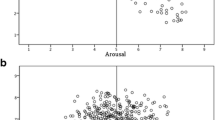Abstract
The recognition of tactile apparent movement (AM) is normally a subjective sense. However, quantitative evaluation is necessary when applying tactile AM, an engineering system. In a previous study, we examined the body sway caused by tactile AM under fixed experimental conditions; however, the body-sway characteristics were not fully investigated. In this study, we investigate the body sway caused by tactile AM under fixed experimental conditions. We focused on biological information and body-sway movement, and compared cases where the apparent motion was recognized and not recognized. We propose the possibility of controlling body sway using tactile AM. Our findings will help improve the performance of systems that use tactile AM.







Similar content being viewed by others
References
Kirman JH (1974) Tactile apparent movement: the effects of interstimulus onset interval and stimulus duration. Percept Phychophys 15:1–6
Mizukami Y, Sawada H (2006) Tactile information transmission by apparent movement phenomenon using shape-memory alloy device. In: Proceedings 6th International Conf. Disability, Virtual Reality and Association Tech, Esbjerg, Denmark
Ueda S, Uchida M, Nozawa A, Ide H (2007) A tactile display used phantom sensation with apparent movement together (in Japanese), IEEJ Trans FM 127(6): 227–284
Kawahara K, Park YI, Uchida M (2009) Characteristic Extraction of EMG with Recognition of Tactile Apparent Movement (in Japanese). IEEJ Trans. SM 129(6):187–188
Park YI, Uchida M (2009) Analysis of surface EMG with apparent movement of Tactile sense. In: Proceedings of the SICE Annual Conference, 2006, 2C12-6
Park YI, Uchida M (2010) Swing analysis of body-parts motion accompanied by apparent movement. In: the International Symposium on artificial life and robotics 2010 (AROB 15th), 2010, OS1-4
Tran HD, Cuntai G (2007) Feature selection based on fisher ratio and mutual information analysis for robust brain computer interface. In: ICASSP International Conference pp I-337
Mogi K, Uchida M (2011) Mutual information analysis of body sway accompanied by tactile apparent movement (in Japanese). The transactions of the Institute of electrical engineers of Japan. CA publication of Electronics, Information and System Society 131(1): 127–133
Horiba K, Mokhtari A, Mizuno T, Uchida M (2013) EMG analysis and evaluation of body-sway Evoked by tactile stimuli. Electrical Engineering/Electronics, Computer, Telecommunications and Information Technology (ECTI-CON 10th), Krabi, Thailand, 5–17, PaperID:1605
Yujei Z, Yamamoto M, Nakao M, Munakata M (1996) Mutual information analysis of cardiovascular signal (in Japanese). IEICE Technical Report. ME and Bio. Cybernetics 96(379):59–66
Mogi K, Uchida M (2011) Quantitative evaluation of body-sway caused by tactile apparent movement. Artif Life Robot 16(2):266–270
Author information
Authors and Affiliations
Corresponding author
Additional information
This work was presented in part at the 19th International Symposium on Artificial Life and Robotics, Beppu, Oita, January 22–24, 2014.
About this article
Cite this article
Horiba, K., Uchida, M. Control of body sway using a tactile device. Artif Life Robotics 19, 363–369 (2014). https://doi.org/10.1007/s10015-014-0185-6
Received:
Accepted:
Published:
Issue Date:
DOI: https://doi.org/10.1007/s10015-014-0185-6




